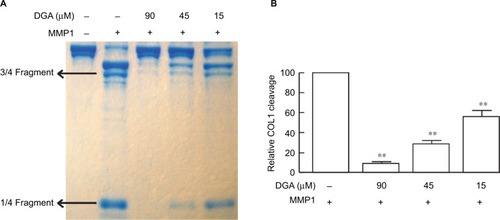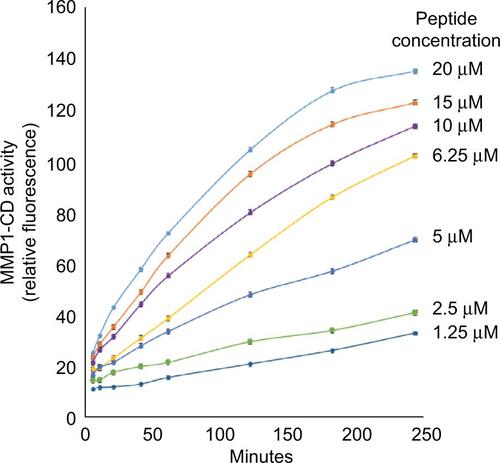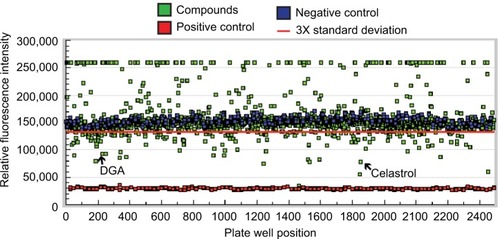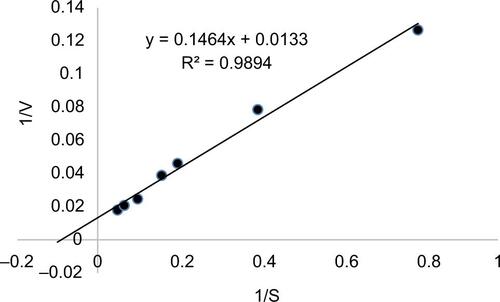Introduction
Type I collagen (COL1) is the predominant structural protein in the skin. COL1 forms densely packed fibrils which are essential for maintaining skin mechanical properties and youthful appearance.Citation1 The enzyme matrix metalloproteinase-1 (MMP1) cleaves COL1 fibrils at a single site.Citation2 Once cleaved by MMP1, COL1 fibrils can be degraded by other proteases. MMP1 expression is elevated during natural aging and chronic sun exposure, ie, photoaging, leading to excessive degradation of COL1.Citation3 This excessive degradation contributes to COL1 deficiency in the skin of the elderly. COL1 deficiency impairs skin structural integrity and appearance.
Given the detrimental role of MMP1 in mediating age-associated fragmentation of COL1 fibrils, it would be beneficial to include MMP1 inhibitors in topical antiaging skin care products. Naturally existing substances that are safe for human use, such as botanical extracts, are often used in skin care products. We have utilized high-throughput screening (HTS) to identify naturally existing MMP1 inhibitors that could be used for cosmetic purposes.
Methods
We adapted the MMP1 activity assay from a previous HTS study, which was designed for identifying MMP inhibitors.Citation4 This assay utilized recombinant MMP1 catalytic domain (MMP1-CD) to cleave a fluorogenic peptide containing the COL1 cleavage sequence.Citation5 Upon cleavage by MMP1, the peptide substrate emits fluorescence. The magnitude of fluorescence is a measure of MMP1 activity.Citation4 We investigated the kinetics of peptide cleavage by MMP1-CD (Figures S1 and S2) and determined optimal assay conditions for HTS. These optimal assay conditions were incubation of MMP1-CD (0.2 ng/mL) with peptide substrate (10 µM) at room temperature (22°C–25°C) for 3 hours.
We applied these conditions to screen 2,000 compounds (the Bioactive-2000 library purchased from MicroSource Discovery Inc., New Milford, CT, USA), which included both natural and synthetic compounds. Test compounds (15 µM) were loaded into 384-well plates using a programmable robotic liquid handling instrument. The results are displayed in . Reactions containing the synthetic MMP1 inhibitor, GM6001, were positive controls (red squares in ) for MMP1 inhibition. These reactions displayed low fluorescence due to inhibition of peptide cleavage by GM6001. Reactions that did not contain test compounds or GM6001 were negative reaction controls (purple squares).
Results
Some test reactions (green squares) displayed fluorescence higher than negative controls, indicating that these compounds may have auto-fluorescence or enhance peptide cleavage. Other test reactions displayed fluorescence lower than negative controls, indicating that these compounds may quench fluorescence or strongly inhibit MMP1 activity.
Among the potential MMP1 inhibitors identified by the HTS, we focused on two compounds celastrol and dihydrogambogic acid (DGA) because they are known to be safe for human use. Celastrol is an active ingredient found in the plant Tripterygium wilfordii, also called Thunder God Vine, which is used in traditional herbal medicine.Citation6 DGA is extracted from a medicinal plant, Garcinia hanburyi. G. hanburyi extracts have been used topically to treat inflammatory skin disorders in China.Citation7 We further examined the effect of DGA and celastrol on cleavage of native COL1 fibrils by using purified full length activated human MMP1. Celastrol displayed little inhibition on COL1 cleavage (data not shown). In contrast, 15, 45, and 90 µM DGA inhibited COL1 cleavage by 44%, 71%, and 91%, respectively ().
Figure 2 DGA inhibits cleavage of COL1 fibrils by MMP1.
Notes: (A,B) MMP1 was preincubated with vehicle or DGA for 30 minutes and then added to native COL1. After 16 hours, COL1 was dissolved in Laemmi loading buffer. Intact COL1 and COL1 fragments were separated by SDS-PAGE and visualized by Coomassie blue staining. MMP1 cleaved COL1 and yielded characteristic fragments with size of “1/4” or “3/4” that of intact collagen. Collagen fragments were quantified using ImageQuant software. Results are mean ± SEM (N = 3; **p<0.01). (A) shows a representative gel.

Discussion
The above results indicate that DGA inhibits cleavage of COL1 by human MMP1. This finding warrants future investigations into the efficacy of topical DGA in reducing elevated MMP1 activity in the skin of experimental animals or humans. In addition, our finding demonstrates the utility of HTS to identify compounds of potential benefit to reduce COL1 cleaving in aged human skin.
Acknowledgments
We thank Diane Fiolek for her help with graphics.
Supplementary material
Figure S1 Kinetics and peptide substrate concentration dependence of cleavage by MMP1-CD.
Notes: To optimize assay conditions for HTS, we examined both the MMP1-CD concentration dependence and the fluorogenic peptide substrate concentration dependence on the kinetics of peptide substrate cleavage by MMP1-CD. This figure shows the peptide substrate concentration dependence of cleavage by 0.2 ng/mL MMP1-CD. MMP1-CD was incubated with peptide substrate at the indicated concentrations for 4 hours at room temperature. Relative fluorescence intensity was monitored at the indicated times. Each point represents the mean of three independent experiments.
Abbreviations: HTS, high-throughput screening; MMP1-CD, matrix metalloproteinase-1-catalytic domain.

Disclosure
The authors report no conflicts of interest in this work.
References
- RittieLFisherGNatural and sun-induced aging of human skinCold Spring Harb Perspect Med201551a105370
- LiYXiaWLiuYRemmerHAVoorheesJFisherGJSolar ultraviolet irradiation induces decorin degradation in human skin likely via neutrophil elastasePLoS One201388e7256324023624
- QuanTQinZXiaWShaoYVoorheesJJFisherGJMatrix-degrading metalloproteinases in photoagingJ Investig Dermatol Symp Proc20091412024
- PeppardJPhamQClarkADevelopment of an assay suitable for high-throughput screening to measure matrix metalloprotease activityAssay Drug Dev Technol20031342543315090179
- BickettDMGreenMDBermanJA high throughput fluorogenic substrate for interstitial collagenase (MMP-1) and gelatinase (MMP-9)Anal Biochem1993212158648368516
- WongKFYuanYLukJMTripterygium wilfordii bioactive compounds as anticancer and anti-inflammatory agentsClin Exp Pharmacol Physiol201239331132021834865
- PanthongANorkaewPKanjanapothiDTaesotikulTAnantachokeNReutrakulVAnti-inflammatory, analgesic and antipyretic activities of the extract of gamboge from Garcinia hanburyi Hook fJ Ethnopharmacol2007111233534017360136


